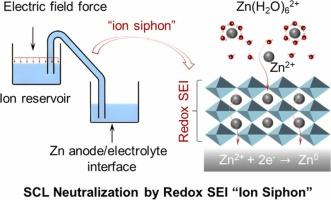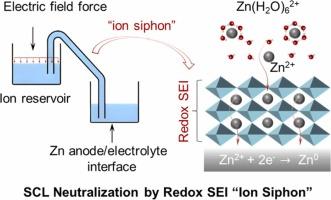高通量离子虹吸中和空间电荷层,实现高速率超稳定锌阳极化学
IF 17.1
1区 材料科学
Q1 CHEMISTRY, PHYSICAL
引用次数: 0
摘要
空间电荷层(SCL)的存在会加剧锌枝晶的生长和副反应,大大缩短锌阳极在水溶液中的使用寿命,特别是在高倍率运行时。传统的界面功能层虽然能有效抑制枝晶和副反应,但由于无法中和SCL,通常会导致额外的电化学极化。在此,我们提出了一种具有氧化还原活性的电子海绵基固体电解质界面(SEI)来解决这个问题。在镀锌/剥离过程中,该SEI在本体电解质和阳极/电解质界面之间充当高通量“离子虹吸”,显著地中和了SCL的负面影响。原位拉曼光谱、弛豫时间(DRT)分布和相场模拟有力地证实了“离子虹吸”功能,这是通过在ZnSO4电解质中仅加入2 mM K6V10O28·9 H2O (KVO)实现的。因此,具有氧化还原SEIs的对称锌电池在高速率下显示出明显降低的极化和长期可循环性(在10 mA cm−2/1 mA h cm−2下超过1200 h)。在10 A g−1条件下,由活性炭(阴极)组装的锌离子杂化电容器(ZIHC)的容量是ZnSO4电解质的2倍,80000次循环后的保留率为92.4 %。这项工作揭示了氧化还原SEI作为高通量“离子虹吸”来中和SCL,这可以应用于其他水基金属储能系统。本文章由计算机程序翻译,如有差异,请以英文原文为准。


A high-throughput ion siphon neutralizing space charge layer towards high-rate ultrastable zinc anode chemistry
Space charge layer (SCL) usually aggravates Zn dendrite growth and side reactions, greatly shortening lifespan of Zn anode in aqueous electrolytes, especially under high-rate operation. Traditional interfacial functional layers, despite efficacy in inhibiting dendrites and side reactions, usually cause extra electrochemical polarization due to the failure to neutralize the SCL. Herein, we initiate an electron sponge-based solid electrolyte interphase (SEI) with redox activity to solve this issue. During Zn plating/stripping, this SEI functions as a high-throughput “ion siphon” between bulk electrolyte and anode/electrolyte interface, remarkably neutralizing the negative effect of SCL. In situ Raman spectroscopy, distribution of relaxation times (DRT), and phase-field simulations strongly corroborate the “ion siphon” functionality, which is realized by adding only 2 mM K6V10O28·9 H2O (KVO) into ZnSO4 electrolytes. Consequently, symmetrical Zn cells with redox SEIs displays evidently lowered polarization at high rates and long-term cyclability (over 1200 h at 10 mA cm−2/1 mA h cm−2). Zn-ion hybrid capacitor (ZIHC) assembled with activated carbon (cathode) delivers 2-fold higher capacity than that in ZnSO4 electrolytes at 10 A g−1, with a 92.4 % retention after 80000 cycles. This work unlocks redox SEI as high-throughput “ion siphon” to neutralize SCL, which could apply to other aqueous metal-based energy-storage systems.
求助全文
通过发布文献求助,成功后即可免费获取论文全文。
去求助
来源期刊

Nano Energy
CHEMISTRY, PHYSICAL-NANOSCIENCE & NANOTECHNOLOGY
CiteScore
30.30
自引率
7.40%
发文量
1207
审稿时长
23 days
期刊介绍:
Nano Energy is a multidisciplinary, rapid-publication forum of original peer-reviewed contributions on the science and engineering of nanomaterials and nanodevices used in all forms of energy harvesting, conversion, storage, utilization and policy. Through its mixture of articles, reviews, communications, research news, and information on key developments, Nano Energy provides a comprehensive coverage of this exciting and dynamic field which joins nanoscience and nanotechnology with energy science. The journal is relevant to all those who are interested in nanomaterials solutions to the energy problem.
Nano Energy publishes original experimental and theoretical research on all aspects of energy-related research which utilizes nanomaterials and nanotechnology. Manuscripts of four types are considered: review articles which inform readers of the latest research and advances in energy science; rapid communications which feature exciting research breakthroughs in the field; full-length articles which report comprehensive research developments; and news and opinions which comment on topical issues or express views on the developments in related fields.
 求助内容:
求助内容: 应助结果提醒方式:
应助结果提醒方式:


